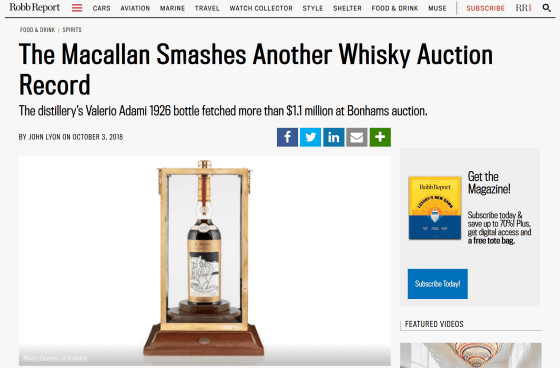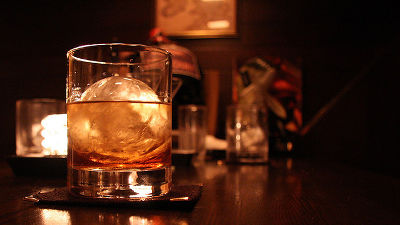Thanks to nuclear tests, it turns out that `` vintage whiskey is more than half counterfeit ''

by
Scotch whiskeys made in Scotland are very popular all over the world, but vintage scotch whiskeys made more than a few decades ago are very expensive among collectors. Analysis of such vintage whiskeys using radioactive isotopes of carbon has revealed that 'many vintage whiskeys are counterfeits not old enough to be labeled.'
USING CARBON ISOTOPES TO FIGHT THE RISE IN FRAUDULENT WHISKY | Radiocarbon | Cambridge Core
https://www.cambridge.org/core/journals/radiocarbon/article/using-carbon-isotopes-to-fight-the-rise-in-fraudulent-whisky/75071F4AB4D7A231B714102B0FE8F5C6
Nuclear fallout reveals fake 'antique' whisky | Live Science
https://www.livescience.com/nuclear-bomb-carbon-fraudulent-whiskey.html

In recent years, 100% malt (
The Macallan Valerio Adami 1926 Sets Record at Bonhams Auction – Robb Report

A problem that emerged at the same time as the rise in the popularity of vintage whiskeys was the 'proliferation of vintage whiskeys with forged manufacturing years'. Counterfeit whiskeys, mainly dating from the 19th to the mid-20th century, have an adverse effect not only on buyers, but also on auction houses, retailers, distillers and brand owners. On the other hand, the whiskey industry does not have an accurate analysis method to identify products that have counterfeited the year of manufacture, and even if it is a real vintage whiskey, it cannot identify the true year of manufacture. That.
'The surge in willingness to buy these scarce products for investment purposes is increasing the number of fraudulent products that are difficult to detect,' said a research team at the University of Scotland's Union Center for Environmental Research (SUERC) . The research team at SUERC has devised to use radiocarbon dating using the radioactive isotope of carbon-14 in whiskey.
A series of nuclear tests in the 1950s and 1960s released carbon-14, a radioactive isotope of carbon, into the atmosphere. The released carbon-14 is absorbed by plants and organisms, and continues to decrease at a constant rate even after the organisms die. Since carbon-14 is also present in barley harvested to make whiskey, measuring the amount of carbon 14 contained in the manufactured whiskey can determine the approximate age of the whiskey made The research team claims.

by
The research team considers the possibility that harvested barley will be stored for more than several years, and data on the amount of carbon 14 contained in `` whiskey manufactured from 1950 to 2015, whose exact distillation year is known '' And made it the standard for measurement.
And the research team actually investigated vintage whiskey that was supposed to be manufactured from 1847 to 1978, and found that almost half of the bottles were not old enough to be printed on the label. For example, one whiskey that was said to have been made in 1863 may have actually been distilled between 2007 and 2014.
The team commented, 'Our experiments indicated that a significant number of counterfeit whiskeys were sold,' and said that caution was required when buying vintage whiskey.

by Piotr Miazga
Related Posts:







